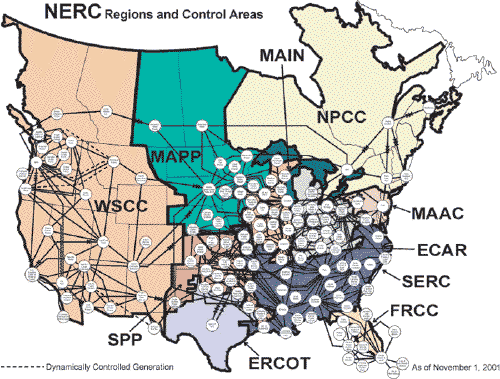Needed: Smart Grid

Sorry to do this two days in a row, but Renewable Energy Access is on a roll. Today’s great content revolves around rebuilding the electrical grid.
Creating a 21st Century Grid
by Stephen Lacey, Staff WriterIn 1957, as Eisenhower began his second term as U.S. President, the first satellite launched into orbit and the first commercial nuclear reactor came online, electrical workers all over the country were installing the world’s most advanced transmission and distribution (T&D) system. Today, much of that T&D system installed 50 years ago remains in place, holding together a patchwork grid for ever-expanding electricity markets.
“You have to think much more distributed than centralized, you have to solve the problem of storing energy, and it has to be much more like an internet system than the current grid is today in order to be effective.”
Dr. Wade Adams, Director, Richard E. Smalley Institute for Nanoscale Science and Technology
Now in 2007 – the age of the internet, personal digital media and distributed energy — the grid has failed to keep pace with the rapidly changing technological landscape. While most industries rely on technologies that have been invented or updated in the last few years, the electricity delivery industry uses technologies that have more or less stayed the same for 100 years.
There’s a common idiom that goes, “if it ain’t broke don’t fix it.†While the grid in the U.S. is hardly broken, it is beginning to deteriorate rapidly in some places, and it will need some serious repairs in order to meet the growing demand for electricity in general and distributed renewable electricity specifically.
“We need to see a very substantial transformation of the system,†says David Meyer, Senior Policy Advisor in the Office of Electricity Delivery and Energy Reliability at the U.S. Department of Energy (DOE). “We’re outgrowing it in many parts of the nation. It’s certainly not the high-capacity, integrated and smart system that we need.â€
The current grid is a stiff arrangement of one-way transmission lines, centralized generation facilities and aging substations. The recent emergence of large amounts of renewable electricity in markets around the country are creating new challenges for both the transmission and distribution sectors.









“Smart Grid”, whenever I hear those words, it make my head hurt. The current problems of our electric transmission network have very little to do with technology and very much to do with regulator vs. utility vs. larger government dis-function.
There just isn’t much incentive for anyone to really step up to transmission infrastructure upgrades. Every prospective developer faces huge NIMBY issues. Regulated utilities see “iffy” merchant developers requiring firm bids for capacity (for which the S&P will incrementally downgrade their bonds). Regulators see the commitment as a cop out from DSM regardless of who is building it. Merchant developers see all the squabbling and the resultant hesitancy of the financial community to back their plans. Even where all of the above can agree, there are new entities (ISOs, RTOs, etc.) who must be consulted with if not directly obeyed.
Until the rules change, the only wise option (for most market participants) is to “get by with what we have, for now.” And that’s just what they are doing.